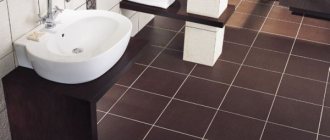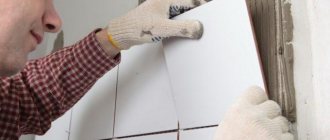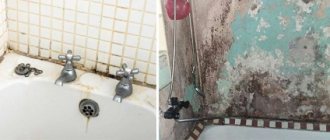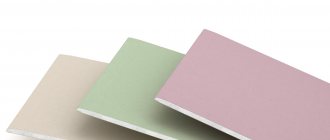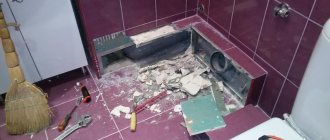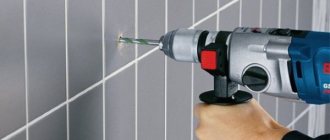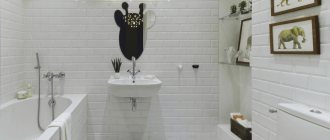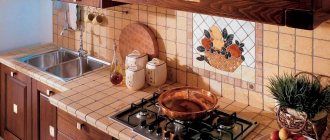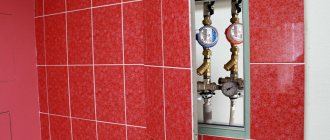Keeping tiles clean requires the use of available and special tools. In this case, it is necessary to take into account the intensity of contamination and the type of tile itself.
We will tell you in this article how and with what to clean tiles in the bathroom.
Causes of plaque formation
The surface of the tiles in the bathroom is constantly exposed to water, soap solutions, and cosmetics. The liquid part evaporates, the drops dry out, leaving stains of salts, lime and other substances dissolved in water on the shiny tile.
It is not difficult to clean the tiles from dirt: water-soluble salts are wiped off with a sponge or rag. But in some cases, stains cannot be removed. The reasons for this may be:
- increased water hardness: after the moisture evaporates, insoluble lime compounds remain, which form white stains on the tiles;
- leaking taps: they stain the wall with rust, and after the drops dry, the yellowness is difficult to wash off;
- mold fungi: colonize tile joints, constantly appearing on the surface in the form of dark spots resembling dirt, and an unpleasant odor appears in the bathroom;
- consequences of the repair: drops of lime, paint, putty or grouting materials are easily washed off until completely set (within 24 hours), and after that they are more difficult to remove.
Washing tiles in the bathroom.
How to remove tile stains after bathroom renovation
During any work with glue and primer, it is almost never possible to avoid contamination of the bathtub itself and the facing tiles. This dirt needs to be removed.
Adhesive solution and silicone sealant
Simple scraping can result in unwanted scratches. Pre-wetting with a liquid for cleaning construction guns from polyurethane foam helps a lot. After this, traces of glue and primer are removed with a rag.
Traces of glue and sealant on the bathtub after repair work
Primer, cement and grout
A product from Finland, Kiilto Clean, is designed to remove grout and primer residues after wall covering. Experienced users use this product for regular cleaning and washing of walls. The product is fireproof. But you must wear protective gloves when working.
General cleaning recommendations
You need to choose a cleaning agent to remove stains from tiles depending on the type of coating (tile, plastic, terracotta, etc.), as well as taking into account the type of dirt. Fresh stains of any origin can be easily wiped off with a soap and soda solution. Soda, as a soft abrasive, can even cope with rust or lime salts. But old stains will have to be removed with aggressive household chemicals.
Washing tiles with soap and soda solution.
To prevent damage to the wall covering during cleaning, you must follow the following rules for caring for it:
- when using acid-containing chemicals, protect tile joints;
- do not use hard metal sponges and brushes, do not scratch stains with a knife;
- It is better to choose thick gels;
- It will be possible to wash the tiles without streaks only by thoroughly rinsing the surface;
- After treatment, mirror glass tiles must be wiped with window cleaners until they shine.
Cleaning ceramic tiles with special cleaners
There are many special cleaning products on sale that remove limescale, traces of rust, mold and all kinds of dirt.
One of the special tools
Another special cleaner
Home Remedies
Improvised products are used in emergency situations, when you need to wash away dirt, but it is not possible to buy a suitable product. Limescale removal is carried out using acidic solutions:
Vinegar and lemon juice remove limescale from tiles.
- Vinegar dissolves traces of water droplets and will help remove grout or lime stains. Table varieties should be diluted with water 1:1, and for essence use 1 tsp. for ¾ glass of water. Soak a cloth in the solution and wash the tiles, rinse and wipe.
- Lemon juice or acid solution works in the same way as vinegar. You can use pure lemon juice or an acid solution of 1 tsp. for 1 glass of water.
You can remove cloudy deposits from drops of soapy water on the lining near the sink and bathtub using baking soda: moisten the powder, apply it to a sponge and wipe the wet wall. Rinse off the remaining soda with plenty of water so that there are no streaks from the powder itself.
An old toothbrush is useful for cleaning tile seams, joints in corners and other hard-to-reach places. It is convenient to treat smooth walls with a sponge. For wiping dry, rags made from natural fabrics are suitable.
How to wash tiles using improvised detergents
In addition to special products, experienced housewives use products from household supplies.
A mixture of baking soda and washing powder is very effective. Two and a half tablespoons of soda are dissolved in one glass of hot water, then one tablespoon of washing powder is added and stirred. This mixture removes mold well and prevents its reappearance.
Dishwashing or glass cleaning products
Dishwashing liquid or soda solution with four tablespoons of soda per liter of water removes minor dirt well. The mixture is applied to the tile. After a few minutes, everything is washed off with water.
Soda, vinegar or citric acid
The most common and accessible means available are baking soda and vinegar. Every housewife has them. A mixture in the proportion of 2 tablespoons of soda plus 100 ml of vinegar per 200 ml of water washes dirt off the tiled wall very well.
Citric acid, being a product of organic origin, is considered the most gentle among acids.
Bleach, ammonia or hydrogen peroxide solution
Another homemade recipe for cleaning tiles uses 100 g of hydrogen peroxide, 50 g of liquid laundry soap and 5 g of soda. This mixture should be applied to the cladding, after 10 minutes you can wash off the dirt. But remember that hydrogen peroxide discolors paints.
Related article:
How to wash a mirror without streaks : with water, household chemicals, folk recipes, a miracle microfiber cloth; how to wash complex stains from limescale, stickers and markers from a mirror - read the publication.
Cleaning tiles using traditional methods
If the use of reliable but caustic chemicals is not possible, you can remove dirt and stains on the walls of the bathroom and bring the tiles to a shine using the folk method. You will need:
- 100 ml hot water;
- 100 g of sound soap shavings;
- 2 tbsp. l. hydrogen peroxide;
- 2 tbsp. l. table vinegar (6-9%);
- 75 g baking soda.
Using a special solution prepared at home, you can give the tiles their former shine and shine.
Dissolve the soap in water, adding it in small portions. Add baking soda powder and leave the mixture for 24 hours. Add the remaining ingredients, moisten the tile with water and apply the prepared mixture. Leave for 5-7 minutes, then rub the seams with a brush, rinse the surface of the wall or floor with a sponge. Finally, rinse thoroughly with water and wipe dry.
An ammonia aqueous solution, which is used to wash glass, will also work well with stains on tiles or other glossy tiles (porcelain, mirror, etc.). Ammonia is used after washing the walls in the bathroom to bring the tiles to a shine. Glass cleaners can be used for the same purpose.
Cleaning rules at home
Caring for tiles is easy. Simply wipe the walls with a damp cloth and clean them weekly using a suitable cleaning product. If this is not done, dirt will soon appear that is more difficult to get rid of.
Rules that will help keep the tile surface clean for a long time, without the appearance of severe contamination:
- after bathing, you need to wipe away any drops of water that get on the wall;
- Do not use cleaning products that contain abrasive components;
- periodically the surface should be wiped with a damp sponge;
- It is advisable to treat sutures with antifungal drugs;
- After cleaning, the walls must be wiped with a dry, clean cloth.
Mold
High indoor humidity often causes mold to grow. The place of localization is the corners and seams between the tiles.
To prevent the appearance of black spots from mold, the surface is periodically treated with antifungal solutions.
The following steps will help dry the air in the room:
- it is important to normalize the operation of the ventilation system;
- It is better not to close the door to the bathroom so that a fresh flow of air always penetrates inside;
- After bathing, be sure to wipe the tiles dry;
- Leaking plumbing fixtures should be repaired.
Other causes of mold include:
- improper laying of tiles in violation of norms and regulations;
- poor ventilation in the room;
- poor room cleaning;
- reduced air temperature;
- Frequent use of the room (for example, washing and drying clothes).
Initially, select a cleaning agent that can remove mold. Among household chemicals, such drugs as Domestos, Sif, Bos, and Belizna successfully cope with the task. Folk compositions are chosen based on components such as soda, vinegar, and copper sulfate.
Mold often appears in the joints between tiles. The best option to get rid of it would be to replace the damaged area:
- The area with mold is cleaned of grout.
- Then you should treat the area with an antiseptic solution.
- Leave the preparation to dry.
- Then dilute a small amount of the desired grout.
- Cover all treated areas.
Limescale
The water that flows from the tap contains a large amount of salts and lime. These components are necessary, because without them, water becomes dangerous to human health. Limescale deposits appear as a result of frequent contact with hard water on the surface of the tiles. Heavy salts contained in water accumulate. In this case, white stripes will appear on the tile. Soft water also creates plaque on the tiles, but it is much easier to get rid of.
Chemicals such as Mister Muscle, Silit, and Comet help remove lime deposits. It is possible to clean the wall from limescale formation with a soap solution, compositions with acetic or citric acid, hydrogen peroxide, and ammonia.
See also
25 chemical and folk remedies on how to quickly remove mold from walls in an apartment or house
The following recipes will help remove limescale in the bathroom:
- Make a mixture of hydrogen peroxide, baking soda and dish detergent. The resulting product is applied to the dirty area, lightly rubbed with a sponge and wait 7 minutes. Then you need to rinse the tiles with clean water.
- Diluting regular bleach in warm water is effective. It is better to pour the solution into a container with a spray bottle and spray the walls. The composition is left for 6 minutes and washed off with water.
- Limescale formations are easily removed with citric acid. The component is diluted with water. The finished solution can be sprayed onto the contaminated areas.
- A mixture of laundry soap and baking soda will get rid of the limescale layer. The crushed soap should be dissolved in a small amount of warm water, and then soda should be added. The mixture is applied to the tiles and washed with water after 35 minutes.
It is recommended to wash off plaque immediately after detecting it. The more time passes, the more difficult it will be to remove it from the surface.
Removing yellow plaque
Over time, especially if poor care has been carried out, an untidy yellow coating appears on the tiles and seams. To restore the original appearance of the tiles, you will need to choose an effective product.
Work to remove the yellow plaque that has accumulated over the years will take some time:
- First, take a toothbrush and carefully clean the dirtiest areas. It is necessary to wash off the cleaned dirt with water as often as possible.
- If there is limescale, then use a composition with soda or vinegar. The solution is distributed over the problem area and left for 12 minutes.
- Vinegar works well for remaining stains. Soak a napkin in vinegar and wipe the areas with a yellow coating.
- At the last stage, you will need to thoroughly wash off the remains of all components from the tile.
If after each use of the bath you wipe the walls with a dry cloth and wash them with cleaning products every 6 days, then no yellow coating will appear.
Detergent residues
Over time, the remnants of washing body gels, balms, shampoos, and soaps begin to accumulate on the tiles. Due to soap stains, the glossy surface of the tile becomes matte.
Compositions prepared according to folk recipes will help you get rid of the remnants of cleaning products:
- Vinegar will help get rid of dirty stains. In addition, the component has disinfectant properties.
- Alcohol-based compositions quickly clean the surface of any contaminants.
- Lemon juice or acetic acid will remove soap stains and restore shine and cleanliness.
- If the tile has a glossy surface, then using chalk is effective. Soap powder is dissolved with water to a pasty consistency. The resulting composition is rubbed in using a white sheet of paper.
Specialized household chemicals
Many products only remove fresh dirt well. It is difficult to remove old limescale or rust with them.
Silit Bang dissolves fats and breaks down lime deposits.
At home, it is convenient to use strong but not too aggressive drugs:
- "Silit Bang". Breaks down fats, dissolves lime deposits, and can remove yellow rust stains. The composition is non-aggressive towards all materials used for cladding: it can be used to clean acrylic and various types of plastic, porcelain stoneware, tiles with various surfaces, glass.
- "Mister Muscle". Dissolves soap and lime stains, is easily washed off with water and leaves no marks on different types of wall coverings.
- "Comet". The products are available in the form of sprays and gels with cleaning properties. If you need to quickly wipe clean surfaces to maintain shine, use a spray, but it is more convenient to treat difficult stains with gels.
- Kiilto Clean for tiles. The product contains oxalic acid and is harmless to glossy glazed ceramic surfaces, but can damage gypsum grout.
- "Domestos". Thick gels and sprays have a bactericidal effect. The bathroom will not only be clean, but also safe for health. When mold appears, the tile joints are treated with thick gel.
Domestes rids tiles of mold.
Cleaning dirty, greasy tile floors in the kitchen: remedies, tips
The kitchen is a room that gets dirty very often. The reason for this is the constant cooking process (spilled liquids, debris falling on the floor, boiling and shooting oil, soot and scale). As a result, the tiles on the walls and floor are heavily covered with a layer of grease.
How to delete:
- You should use a product that contains alcohol or acid. They eat away fat, making it more “liquid,” which makes it easier to remove from surfaces.
- Special chemicals or alcohol will help you remove greasy deposits.
- After such cleaning, the surface can be washed with soap or all-purpose solution.
- To make the tiles shiny, they should be rubbed with glass cleaner.
How to clean tiles in the kitchen?
Features of washing different types of tiles
When trying to wipe dirt off tiles, it is advisable to take into account the nature of the surface. On smooth, glossy walls, plaque forms quickly, but it is easy to visually detect and remove immediately. Other types of ceramic tiles need to be cleaned properly to achieve a satisfactory result.
Glossy
Glossy surfaces are especially difficult to keep clean. But it is also easier to remove stains from them than from other types of tiles. Plaque is removed from the glaze using chemicals that contain ammonia or ethyl alcohol: these are most products for window glass. The preparations are equipped with a spray bottle, are easy to apply, and when wiped dry, the surface becomes shiny.
Window glass cleaners are most often used to clean glossy surfaces in the bathroom.
Matte tile
Ceramic tiles without glaze are covered with stains from soap solutions or water. You can eliminate them:
- acidified water (0.5 cup per 5 liters of water), if they are caused by lime deposits;
- a solution of soda ash (3 tablespoons per 5 liters of water);
- special polish.
Cleaning matte tiles in the bathroom.
Embossed
The textured surface of the tile makes it difficult to remove dirt with a simple rag or sponge: not only plaque or rust remains in the small recesses of the pattern, but also dirty water after washing. If they are not removed immediately, they will create a dark coating. For cleaning, it is better to use special products that are completely washed off. The most convenient way to clean an uneven surface with an ornament or simply a fine texture is with a brush. After washing, it is advisable to wipe the wall or floor with moisture-absorbing material.
It is better to wash embossed tiles with special products.
Floor
For bathroom flooring, tiles with fine relief or without glaze are often used. These types are the safest: they will not allow you to slip on a wet floor. They need to be cleaned taking into account the characteristics of the surface, according to the rules for matte or embossed tiles. For floor tiles, special polishes are used (Emsal, etc.), which do not allow dirt to seep into the micropores of the ceramic.
For flooring, you should choose special polishes.
Removing limescale from tiles using chemical means
From constant contact with moisture, white spots appear on the surface. Splashes of water fall on the walls, leaving a limescale deposit after drying. The density of the resulting layer increases, and it becomes difficult to wash it off over time. Conditions in the bathroom are favorable for the development of mold and mildew. They look unpleasant and harm the health of the body’s respiratory system.
Household chemicals can easily help remove stains. When using them for tiles, read the manufacturer's recommendations so as not to harm the elements when washing or grouting joints. Aggressive substances cause discoloration of the material in the bathroom.
Professional anti-plaque preparations contain ammonia, isopropyl alcohol, and solvents. The products are produced in the form of pastes, sprays, powders, and creamy preparations. Popular laundering agents:
- Mr. Muscle;
- Shining tiles;
- Schumanite for tiles;
- Domestos for bathroom surfaces;
- Sif from plaque;
- Cillit Bang;
- SunClean;
- Amway.
They wash stained tiles, remove plaque, and disinfect bathroom surfaces.
Instructions for use:
- Cover your face with a respirator. Wear gloves.
- Distribute the product evenly over the problem area.
- Rub the sponge over the area where the plaque has formed and leave it for active action for the time specified in the instructions.
- Remove excess detergent with clean water.
- Wipe the tiles dry.
The bathroom door must be open. Constant air circulation will protect against poisoning by chemical vapors.
How to clean the seams between tiles
Cleaning the joints between tiles.
The grout has many pores into which dirty cleaning solution, drops of soapy water and other substances become clogged. Fungus and mold often develop in the pores.
To treat the seams, use a small brush and any cleaning product with bactericidal properties. The composition of a folk or store remedy should not include acid. A soap-soda solution is suitable (for 1 liter of water, 50 g of soap shavings and 2 tablespoons of soda). Add 1 cap of “Whiteness” or 0.5 tsp to it. chloramine.
It is convenient to use a steam generator to clean seams. A jet of hot steam destroys dirt and microorganism spores.
Cleaning tiles with a steam cleaner
The use of a steam cleaner when washing facing tiles allows you to avoid the use of chemicals. Modern steam cleaners are equipped with a steam hose and a set of nozzles that allow you to reach the most difficult to reach places. Hot steam under pressure softens dirt, opens pores, and destroys all microorganisms. After steam treatment, the surface should be wiped with a soft, clean cloth.
Working with a steam cleaner
Mold Removal
Mold appears as small black spots in the joints of tiles. The peculiarity of the fungus is its ability to live and grow deeply into the plaster, from where it is completely impossible to remove it without repairs. A steam cleaner will quickly fix the problem. If mold was already in the bathroom before the new tiles were installed, the effect will be temporary.
Chlorine bleach will help fight mold on tiles.
Chlorine bleaches are effective against fungus on surfaces, but cannot completely destroy it. To permanently fix the problem, you need to use a radical method - remove the old putty and fill the joints with new grout. A special tool is used to remove the gypsum mixture, and the remains are removed with a brush.
Anti-mold treatment is as follows:
- Inject a fungicidal antiseptic into the seams, trying to wet the entire space between the seams (use a syringe);
- dry the wall;
- fill the joints with new putty, pushing it into the depth of the seam;
- wipe the surface of the tiles.
After introducing the fungicidal antiseptic and drying the wall, it is necessary to reapply the putty.
How to get rid of mold and mildew
The appearance of mold in the seams between tiles indicates either insufficient care or unfavorable conditions (constant humidity, lack of ventilation, high temperatures). As soon as you notice the first signs of fungus in the bathroom, you need to take immediate action. The sooner you deal with this problem, the less time you will have to spend solving it.
Mold can be removed in several ways. The first and perhaps most effective is to use a steam cleaner. This device releases a hot stream of steam under high pressure. Steam cleaning will actually “cook” all the mold in the seams and on the surface of the tile, after which the black spots will be easy to remove with a rag.
If you do not have such a useful device as a steam generator, then use more common means. Bleach fights fungus just as well. You need to apply it generously for a couple of hours over all the seams, then wipe off the black spots with a toothbrush or sponge.
In severely advanced cases, you can combine the action of bleach and a steam cleaner. When working with chlorine-containing detergents, protect your respiratory tract and ventilate the room promptly.
If the layer of fungus cannot be cleaned, this means that the dirt has sunk too deeply and you will have to completely change the grout between the tiles. To do this, use a special scraper with removable blades to clean out the entire old affected layer. Dry the seams, remove dust and dry grout residues. Carefully apply the new compound.
Methods for restoring grout
There are several effective ways to update and lighten seams:
Marker for cleaning tile joints.
- Hardware stores sell products for cleaning bathroom tile joints. Markers and pencils allow you to quickly work on a seam by running the end of the lead along it.
- Paint the seams with waterproof paint or varnish and cover with polish.
- Partially renew the grout. This process is often combined with mold removal.
- If the putty has crumbled, it can be renewed by applying a fresh layer of the same composition. Before repairs, treat the joints with a stiff brush to remove the crumbling layer.
Preventive measures
To make it easier to clean bathroom tiles until they shine, you need to follow preventive measures. The main enemy of ceramics is condensation. It accumulates in the bathroom after using the room. It is necessary to ensure good ventilation in the bathroom and heating in winter. It is recommended to wipe the tiles after each bath and shower. In addition, try to avoid other contaminants left by hygiene products and powder.
Ceramic tiles in the bathroom must be washed with detergents at least 2-3 times a month. To maintain the shine of a glossy finish, it is recommended to use home remedies or special impregnations and varnishes.
In order not to spend a lot of time and effort on caring for tiles, it is better to take simple preventive measures.
Useful tips and prevention
To ensure that the seams are less exposed to moisture or cleaning agents, it is recommended that they be treated with a moisture-proof compound immediately after the repair is completed. The grout will last longer. Polishes are also applied to tiles with a porous surface (unglazed).
The best prevention of stains on tiles is timely cleaning. It is easier to wipe the walls when the stains have not yet had time to dry to the surface. You need to wash the walls in the bathroom once a week, and clean the seams once every 2-3 weeks.
Ventilation or frequent airing of the bathroom helps eliminate excess moisture. Mold will not grow in such conditions. After washing or taking a shower, it is advisable to wipe off drops of water from the tiles: this way there will be less dampness, and you won’t have to scrub off the stains.
What can and cannot be used?
The tiles used to decorate walls can be different, but they are always durable and resistant to various types of influences. Many people mistakenly believe that such surfaces will withstand any chemical and mechanical means. However, even the choice of compositions intended for cleaning tiles should be considered carefully.
Most often, people choose finishing materials with a glossy surface. For such a coating, the use of abrasive substances and metal or hard brushes will be detrimental.
These products can quickly clean the tiles in the bathroom, but the small scratches they leave will eventually deprive the tiles of their original shine.
When choosing products for cleaning tiles, you must take into account that the joints between the tiles also require care, but the methods and means of cleaning them must be different. Exposure to acid-containing products will be destructive for building materials used as grout.
It is not recommended to use compositions intended for kitchen or plumbing equipment to clean bathroom tiles from limescale. You should also avoid products containing sand, pumice and fatty components.
After treatment with special cleaning emulsions, the matte tile surface should be coated with wax mastic, which will protect the porous surface from absorbing dirt and also highlight the structure and color of the material.
Careful care of tiles involves using:
- soft sponges;
- wool or felt napkins;
- toothbrushes;
- gentle detergents.
